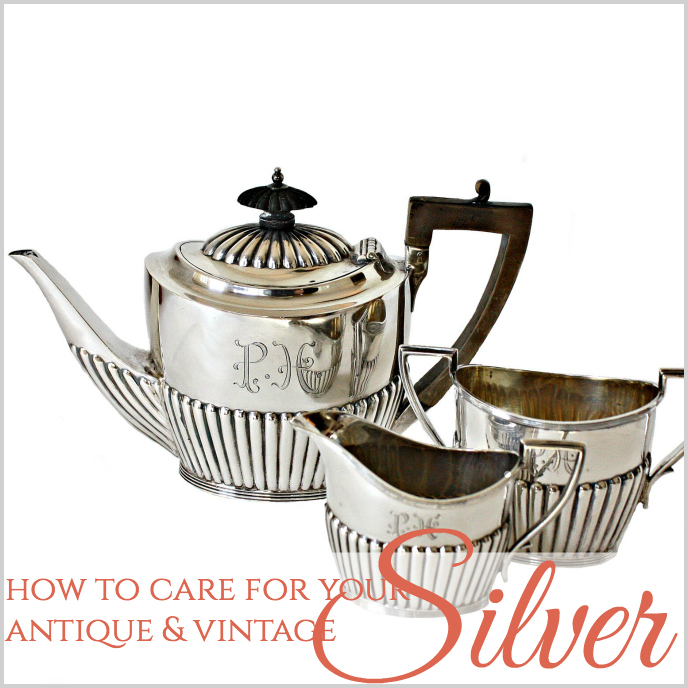
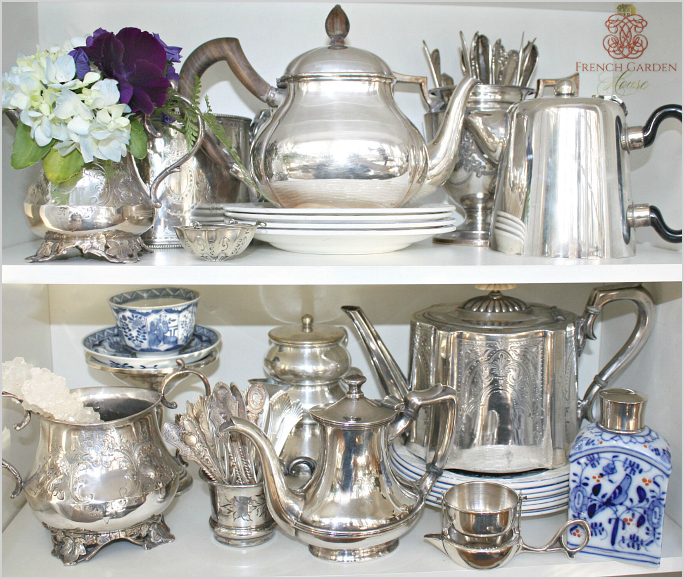
Silver was created to be used every day, to keep it looking its best, using it reduces tarnish, and gives your Silver that patina* we all love and look for. Not only that, using your Silver is so much better than keeping it in a cabinet for “company” or holidays only.
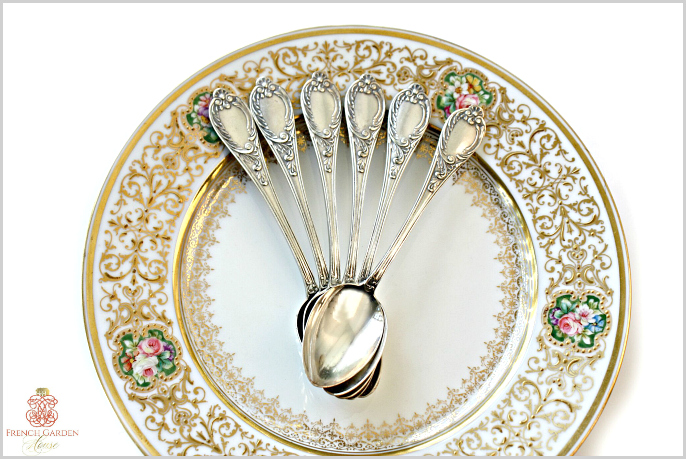
If you use your Silver Flatware every day, it will rarely need polishing, except for the forks, which tarnish quickly because the silver reacts to certain sulfur-containing foods such as Spinach, Eggs, and Onions. A quick rub with a gentle silver cream such as Twinkle will remove it. Don’t let your knives soak in water as the handles can loosen, plus the minerals in tap water aren’t all that good for Silver, so a quick wash is better.
If you have a large service, don’t forget to rotate the pieces so that they all get the same amount of wear, and patina over time.

I hand wash all my Silver. I know that many people put it in the dishwasher, but it’s so worth the time to wash and dry by hand. The heat and harsh detergents will eventually whiten your Silver. If your Silver touches stainless steel while in your dishwasher, it can develop black spots that never come out.
For Silver Plated items, the dishwasher will wear down the plate. Instead, wash your Silver in hot water with {non-Lemon Scented} dish detergent. Rinse well with hot water and dry immediately with a soft kitchen towel. {Be sure to dry the inside of your pitchers, bowls, and teapots completely}
Do not allow Silver to air dry as water left on it can cause unattractive spotting or worse, corrosion if there is water in little areas that don’t dry quickly.
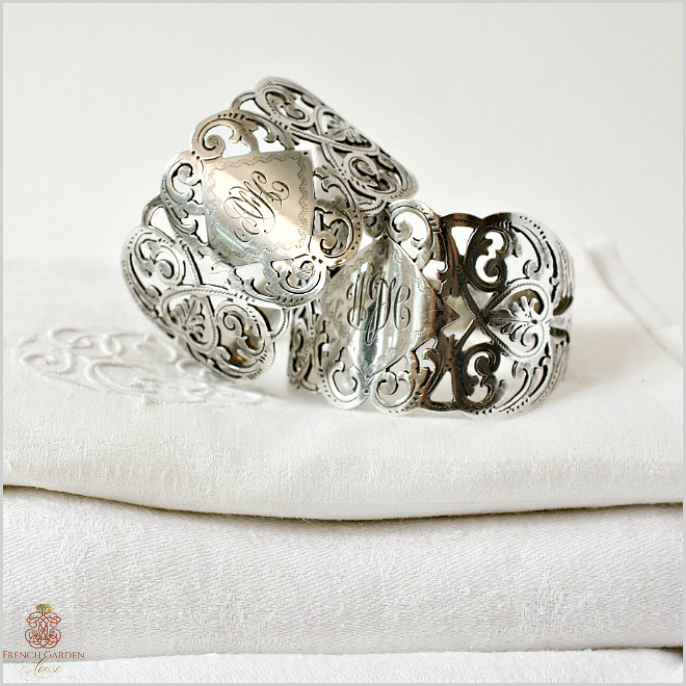
STORAGE: Store your silver forks, knives, spoons and serving utensils in a cutlery chest lined with anti-tarnish silver cloth, or in a drawer lined with silver cloth. Hagerty and Pacific Silvercloth sell bags, rolls and cloth to use in storing your Silver correctly.
Silver bowls, trays etc. that are not on display should be wrapped in archival tissue paper and placed in silvercloth bags. Make sure you don’t let rubber bands, felt or newspapers touch stored silver, they contain chemicals that can make black marks on your pieces that will be impossible to get off. Plastic wrap can break down and produce moisture condensation that will attack your Silver, so it’s best not to wrap your pieces in that, either.
CLEANING: To keep Silver bowls, trays, candlesticks and other decorative pieces gleaming, all they really need is a brief buffing, maybe once a week, using a pair of special silver mitts or polish cloths. Impregnated with a gentle silver cleaner, these are kind of fun to use, and the polish inhibits the tarnish. The benefit of cleaning with the mitts is that when special dinners or holidays come along, it will take a lot less work and effort to clean these pieces.
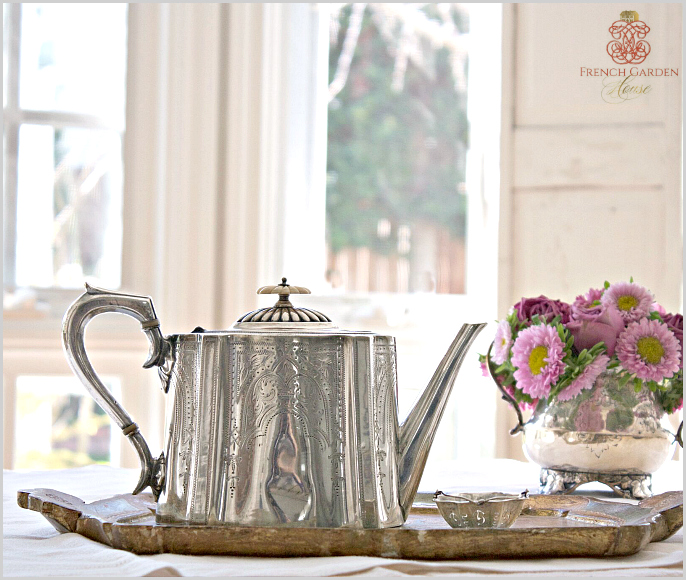
POLISHING SILVER:
Recommended Silver polishes include Goddard’s Long Shine Silver Polish, Wright’s Silver Polish, and Twinkle Silver Polish. These products are gentle, so many others, including the so-called all-purpose metal cleaners, are too abrasive and will scratch your pieces and strip a layer of silver off.
-
1. Wash your Silver first. Line your sink with an old Towel, so you won’t scratch your pieces, and fill with hot water and a little dishwashing soap {non-lemon-scented phosphate-free.} Wash your piece, then dry off gently.
-
2. Apply the polish according to the instructions on the container with a soft, clean cloth using a gentle, back and forth motion. Use cotton swabs or an old very soft toothbrush to clean applied ornamentation, but don’t overdo it as darkening around these areas really shows the design, and you want to keep that!
-
3. Rinse the polish off with hot water and dry thoroughly. Buff the Silver to a soft luster, using a soft cloth and as little “elbow grease” as possible. Over-enthusiastic polishing can rub off hallmarks and remove the silverplate, revealing the base metal underneath.
-
4. Don’t wear rubber or latex gloves when cleaning and polishing silver – rubber and silver don’t mix.
-
5. For pieces that can’t get wet, I use the Long Shine Silver Polish, because that just dries on the piece and you buff it to a shine that way.
-
6. Optional, but this is what I do: Turn on a favorite cooking show, or some great music, and drink tea while polishing. This is a chore, but no one says you can’t enjoy it while you are doing it!

DIPS & ELECTROLYTIC CLEANING METHODS:
I don’t recommend using the chemical dips such as Tarn-X, because they are much too harsh. Dips work by dissolving the tarnish on an object at an accelerated rate. Submerging the piece for long periods will remove factory-applied patinas and can cause pitting on the surface, which then causes your piece to tarnish more quickly. If the chemicals get into cracks and crevices, or the often hollow little feet on teapots and trays, they can stay there and eat away at the silver.
I have seen so many antique and vintage Silver treasures that now look like Stainless Steel, or Yellow, because the person who owned them, or was selling them, dipped them instead of polishing, removing all the gorgeous patina and luster we love. You can’t turn back the clock on patina.
Electrochemical Cleaning involves placing silver in a plastic bowl lined with aluminum foil and filled it with boiling water plus baking soda and salt. Silver cleaned this way also looks like stainless steel, loses its patina, and tarnishes far more quickly afterwards. Also, because you have to immerse your silver for the chemical reaction to work, any piece with hollow parts, joints or crevices could trap moisture, which would corrode the silver from the inside.
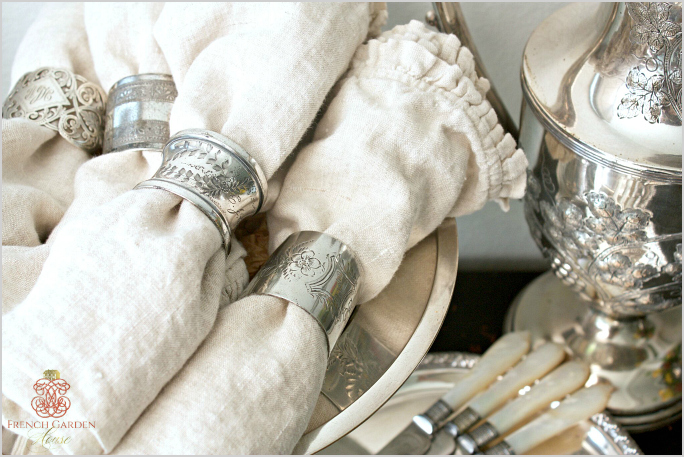
Silver, taken care of right, is not only a joy to live with today, but also to pass on to your children and grandchildren. I have my Grandmama’s Silver teapot, I hope that one day, my daughters and grandchildren will remember tea and meals at our home fondly, and will cherish the silver pieces they inherit from us, with memories of love.
*PATINA: The patina that develops on well-loved Silver pieces results from the oxidization of Silver with the air, so keep your pieces out on display and enjoy them. This is actually a fine film that coats the surface of the Silver. It fills in all the tiny microscopic scratches that occur with use, and gives your Silver that lustrous, mellow and glorious sheen, and protects the Silver as well.
Shop our current collection of ANTIQUE SILVER.
If you want to romance your Home and Garden with antique and vintage treasures to make you smile each time you come home, visit our shop FrenchGardenHouse.

 Your Cart
Your Cart
This is the best advice I have ever heard on polishing silver…and I LOVE my silver!
My aunt gifted me with a beautiful set of sterling. Thank you for the advice.
I agree, clean your silver, I know there had been the era of tarnashed silver for displays at large flea markets like Warrenton Texas and even in the east, however I have decided I like my clean polished silver, I just cleaned my flatware for a ladies brunch last week, it was so pretty!
Nothing as pretty!
Thanks for all the information on how to care for vintage & antique silver. I do have a question, can this type of silve be tumbled with steel shot?
Great post! As a silver restoration, conservation, and preservationst, I can say with certainty that Tarn-X will absolutely ruin your silver.
Wonderful advice. I used to use Tarn-X and I thought that was the best option. I tried Wright’s Silver Polish – only one my grocery store carries – and it worked wonderfully! No fumes, no mess and beautiful results. Thank you LIDY for the wonderful tip!:)
Hi Ida, thanks so much for leaving a comment. I’m glad that you have found something to make your beautiful silver shine. xo
This site was… how do I say it? Relevant!! Finally I’ve
found something which helped me. Thank you!
This is wonderful information! I have several silver pieces and never knew how to get the tarnish off. Thank you so much…….Linda<
Hi Lidy,
I absolutely have to thank you for this. I’ve just taken out the holiday flatware that I’ve only used once. I was so sad when I found they’ve lost some of their shines compared to the time when I bought it. But with this simple guide, I managed to get them glowing again.
Hi, Lidy. Thank you for the post. Could you please tell me the names of a non-lemon scented, phosphate-free dish detergent and dishwasher detergent. I would be SO appreciative as I can not locate either one online or at my local stores. Thank you in advance for any help you may be able to provide.
HI Bobbi, I think a brand called Seventh Generation has some, and Ivory soap makes one, too!
I really like using MAAS polish (it cleans most metals). Someone recommended it at the Brimfield Antique Show a few years back and I’m hooked!
I am a skilled Certified silversmith for all Vintage Silver Specialities.
Use WENOL CREME. ITS THE BEST for all your SILVER. IT’s made in
Germany. So you know the Quality is always Excellent!
We have been selling it in our workshop for years. So easy to use and you will LOVE the results!
Can anyone tell me what the Museum world
think of MAAS polish. is it abrasive to
silver? How does it work and does it cause
any long term damage?
Lisa, MAAS is a fairly abrasive polish. While it works well on truly deeply tarnished pieces, it will eventually strip the silver from plated pieces. I suggest a milder polish such a Goddard’s, which I believe is available in the UK.
how is food served in a plated chafing dish without Pyrex. I was always told never to put food directly on silver. I don’t like the look of the glass insert and my chafer has a plated water bowl and beautiful serving insert. I don’t believe it ever had a glass liner.
Thanks for any comments.
Gary, it is perfectly fine to serve food directly from silver. There are some exceptions, avoid using it to serve eggs or anything that contains eggs, such as pudding, custard, egg salad and mayonnaise, for example. These foods leave a dark stain when they come in direct contact with the silver, they actually tarnish the piece when sulfur in these food products combine with silver. I also don’t recommend using silver to serve citrus, as the acidity can damage the silver pieces. After serving, be sure to wash with hot water and mild detergent, and dry your beautiful silver thoroughly. {and be sure to remove any salt from a silver salt shaker before storing, salt corrodes the silver} Hope that helped, and I hope you enjoy your gorgeous chafer!
Lidy, thank you so much, I now feel comfortable using this beautiful piece.
I read in your article not to store silver in felt. I have heard the terms felt roll and felt bags for storage. Is this just a term used for treated cloth used to make them. I have an abundance of felt and had intended to make my own rolls.
Please Advise,
Thank you
Gary, I was taught by a museum curator of silver never to use felt, but the special silver cloth for storage. Silver Cloth has tiny particles of silver in it, which absorb sulfurs (what tarnishes silver) and that is what they recommend using. {They also use gloves to handle their silver, but since the silver I have at home isn’t really museum worthy, I skip that step!} Silver Cloth can be bought by the yard or in special bags etc., you can line drawers and cabinets with it.
Thanks Lidy, I will now find a new use for my felt.
Hi Lidy, Thanks for your reply re MAAS.
I will look at other ways to store the silver as well.
Lisa
I just purchased a new silver plated “breakfast tray” and it is warped so that it does not sit flat. What can I do to make it sit flat?
Fran, it’s why I never purchase antique trays or other silver that doesn’t sit flat, no matter how gorgeous they are otherwise. Unfortunately, unless you can give it a little shove and “bend” it back, there isn’t much you can do. Perhaps stick a felt circle under the corner where it doesn’t quite touch the table to give that a little height?
I have amazing antiques from my grandma. I am so proud that she gave them to me.
Question: I have silver that sit out as decorative pieces. It seems they have been tarnishing more quickly lately. I’m thinking my cleaning people dust it with their swifter dusters. Do these have a chemical on that can tarnish the silver? What should be used to dust the silver?
Marlene, I’m not 100% sure what would be in your swiffer. I always recommend that silver be dusted with just a soft cloth.
Hello Lidy, I have read your post on cleaning silver and found it to be very helpful. My husband and I were given a set of three, I believe, silver-plated bowls”Pintel Collection by Towle made in India”. Somehow one of these bowls found it’s way in the dishwasher and now this bowl does not have the shine of the other two. I tried washing by hand and also light silver polish but have not been able to bring back it’s shine. Can you please make a suggestion? Thank you for your time! -:Veronica
Veronica, I believe that the Pintel bowls are pewter. I’m not sure what will help that, you could try a polish for metals (hardware store, in a tube) but the dishwasher may have removed the “cover coat” that made your bowl shiny. ugh. So sorry.
Thank you Lidy for your reply. I will give this a try! -:Veronica
I have a silver pitcher from 1854 that is so tarnished it’s charcoal gray. If I shouldn’t use electrochemical cleaning method, what is the best and safest method of restoring this piece?
Elizabeth, you are so fortunate to have an antique piece that old! I suggest you use silver polish, it will take some time and old fashioned “elbow grease” but will be totally worth it! For pieces with that much polishing to do, I take it in steps, and actually place an old terrycloth towel on my kitchen table, put on my latest Netflix binge and watch and polish away. If it takes too much work, I put the whole thing away and repeat. Hand polishing is a lot of work, but so worth it. If you really don’t want to polish it yourself, you can have your piece professionally polished, you should be able to find a silversmith or jeweler in your area who does that by googling Professional Silver Polishing. Good luck! It will be so rewarding to see that gorgeous gleaming antique silver underneath the years of darkening and grime.
I just inherited several of my grandmother’s serving plates and tea sets. Unfortunately, they were not stored properly and were neglected for years. I have used Wright’s silver polish in the past on my own silver pieces. How do I clean with this if I cannot use gloves. Exposing my hands to chemicals for long periods is a health risk. I think they are going to take some work over time, but they seem to be salvageable for the most part.
Ann, is it that you are allergic to latex? Because you can get gloves that are not latex and use those.
I was gifted a beautiful silver vase recently and want to use it to display fresh flowers from my garden. I’m worried that sitting water or bacteria from the plant material may damage it. Is this a valid concern?
Leif, silver actually has inherent bacteria fighting properties. I would suggest that you not use the flower food sometimes used for floral arrangements, and refill your vase with clean water daily.
Thanks so much for this! I have a bunch of old silver I inherited from my grandmother when she passed away and I had no idea how to treat it so I just left it on the shelf for a long time. This was so helpful!
So happy you found this a help, Lindsey. And…how lucky to inherit your grandmother’s silver!
Silver newby (or is that newbee?)…just looking at all the information out there on how to clean, how to store, how not to damage as we’ve inherited pieces that we now must care for. I may begin collecting. You have given me some great reading. I was glad to find your blog!
Thank you Helen! There is no great secret to taking care of silver…just use a good quality polish so you don’t damage your pieces!
Thank you for your article. My mother always had her children polishing for the holidays and now my daughter loves to do it as well with me. It is a bonding time. I have another question for you though, I just acquired a Sheffield tea pot, sugar and creamer (like the set in your first photo – sans monogram). The set was very tarnished, which didn’t deter me, but the handle is now extremely dull. Is there a way to bring the shine back to the handle on the pot
I made the mistake of cleaning an inherited Repousse Pitcher with Tarnx. Now all the silver sulfide black is gone. Is there anything I can do to restore it?
I would allow the piece to age back to {hopefully} some patina. Tarnx is awfully harsh, as you noticed the patina is completely stripped, as is the beautiful black that is actually put in the indentations of repousse work on purpose. Fingers crossed that your pitcher will go back to looking gorgeous once again!
Is it possible to fix sterling silver flatware that has a huge amount of hairline scratch marks (very consistent, however) all over it. It’s sterling, not silver plate but almost appears like it was cleaned with a toothbrush.
I’m hoping it can be repaired. There’s no tarnish and has about a handful of pit marks in the whole large set.
So besides the covering of scratches, that appear to all be surface, the pieces are good.
Thanks. Stella
Stella, unfortunately it sounds like the silver was really mishandled. I’m so sorry. I think your best bet would be to take it to a silver replater, and ask them if there is anything they can do? Perhaps they can buff out the damage to make your beautiful set like new.
What kind of silverware storage tray would you recommend for silver plate flatware that is used daily? I am looking for something that would fit a kitchen drawer. Any suggestion would be appreciated!
Could you please clarify the use of gloves to protect your hands during the polishing process? Rubber, latex???? Please be specific as to what is ok to use with silver and silver polish. My skin is VERY sensitive. Thank you!!
Ellie, neither latex nor rubber gloves are recommended. If you must wear gloves, cotton ones are the right kind of gloves to wear to protect your skin.
May sterling silver or silver plate be re-silvered?
Brenda, yes, they can be although true sterling shouldn’t have to be since it’s almost pure silver. It is a costly process though, so only for pieces that your really value.
I have two silver pieces circa 1890s Meridien S.P.Co, sugar and creamer. They are black and mottled. Are these polishable? What would you recommend?
Thankyou
Gregory, it will take some work, but most silver is polishable. I recommend you get a tube of the Wehnol polish. Good luck!
I have an antique sterling match safe with patina gone from the baking soda, tin foil method – is there a way to restore the patina? Really heartbroken that it’s mellow luster was ruined.
Judy, that is heart breaking. When polishing silver, using a quality polish is always the first choice. I’m not sure if that beautiful mellow luster will come back. I suggest you try to polish it again when it’s tarnished a little bit. Baking soda is really abrasive…wish I had a better and nicer answer for you!
I think there’s hope – I buffed with Nevr-Dull cotton wadding polish and it looks so much better with a warm luster and shiny high points. Over time, letting it tarnish and polishing again, it will come back to life. The case was so badly oxidized, I had to be extreme in removing it, hence the baking soda. Thank you for the reply!
Oh Judith, I’m so glad!It’s always devastating to see silver at markets that have been stripped repeatedly by the baking soda method of all their luster. So happy it will be ok!